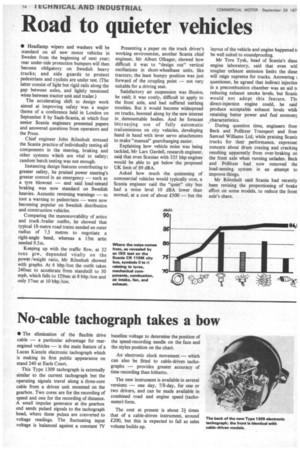No-cable tachograph takes a bow
Page 356

If you've noticed an error in this article please click here to report it so we can fix it.
• The elimination of the flexible drive cable — a particular advantage for rearengined vehicles — is the main feature of a Lucas Kienzle electronic tachograph which is making its first public appearance on stand 240 at Earls Court.
This Type 1309 tachograph is externally similar to the current tachograph but the operating signals travel along a three-core cable from a driven unit mounted on the gearbox. Two cores are for the recording of speed and one for the recording of distance. A small impulse generator at the gearbox end sends pulsed signals to the tachograph head, where these pulses are converted to voltage readings. The fluctuating input voltage is balanced against a constant 7V baseline voltage to determine the position of the speed-recording needle on the face and the stylus position on the chart.
An electronic clock movement — which can also be fitted to cable-driven tachographs — provides greater accuracy of time recording than hitherto.
The new instrument is available in several versions — one day, 7/8-day, for one or two drivers, and can be made available in combined road and engine speed (tachometer) form.
The cost at present is about 2-1 times that of a cable-driven instrument, around £200, but this is expected to fall as sales volume builds up.
































































































































































































































































































































































































































































































































